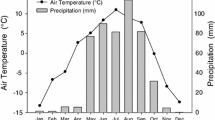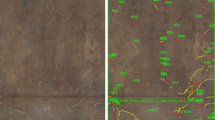Summary
Root biomass production, root length production and root turnover of Erica tetralix and Molinia caerulea were estimated by sequential core sampling and by observations in permanent minirhizotrons in the field. Root biomass production, estimated by core sampling, was 370 (Erica) and 1080 (Molinia) g m-2 yr-1. This was for both species equal to aboveground production. Assuming steady-state conditions for the root system, root biomass turnover rates (yr-1), estimated by core sampling, were 1.72 (Erica) and 1.27 (Molinia). Root length production of both species, estimated by minirhizotron observations, varied significantly with observation depth. Root length turnover rate (yr-1) of both species did not vary significantly with observation depth and averaged 0.92 in Erica and 2.28 in Molinia. Reasons are given for the discrepancy between the results of the two types of turnover measurements. The data suggest that the replacement of Erica by Molinia in a wet heathland, which occurs when nutrient availability increases, leads to an increased flow of carbon and nutrients into the soil-system. Therefore, there may be a positive feedback between dominance of Molinia and nutrient availability.
Similar content being viewed by others
References
Aber JD, Melillo JM, Nadelhoffer KJ, McClaugherty, CA, Pastor J (1985) Fine root turnover in forest ecosystems in relation to quantity and form of nitrogen availability: a comparison of two methods. Oecologia 66:317–321
Aerts R, Berendse F (1988) The effect of increased nutrient availability on vegetation dynamics in wet heathlands. Vegetatio 76:63–69
Aerts R, Berendse F (1989) Aboveground nutrient turnover and production of an evergreen and a deciduous species in a heathland ecosystem. J Ecol 77:343–356
Berendse F, Aerts R (1984) Competition between Erica tetralix L. and Molinia caerulea (L.) Moench as affected by the availability of nutrients. Acta Oecol/Oecol Plant 19:3–14
Berendse F, Oudhof JAF, Bol J (1987) A comparative study on nutrient cycling in wet heathland ecosystems I. Litter production and nutrient losses from the plant. Oecologia 74:174–184
Berendse F, Bobbink R, Rouwenhorst G (1989) A comparative study on nutrient cycling in wet heathland ecosystems II. Litter decomposition and nutrient mineralization. Oecologia 78:338–348
Böhm W (1979) Methods of studying root systems. Springer, Berlin Heidelberg New York
Caldwell MM, Camp LB (1974) Belowground productivity of two cool desert communities. Oecologia 17:123–130
Coleman DC (1976) A review of root production processes and their influence on soil biota in terrestrial ecosystems In: Anderson JM, Macfadyen A (eds) The role of terrestrial and aquatic organisms in decomposition processes. Blackwell, Oxford, pp 417–434
Coleman DC, Andrews R, Ellis JE, Singh JS (1976) Energy flow and partitioning in selected man-managed and natural ecosystems. Agroecosystems 3:45–54
Frissel MJ (1981) The definition of residence time in ecological models. In: Clark FE, Roswall T (eds) Terrestrial Nitrogen Cycles. Ecol Bull (Stockholm) 33, pp 117–122
Lauenroth WK, Whitman WC (1977) Dynamics of dry matter production in mixed-grass prairie in western North Dakota. Oecologia 27:339–351
McClaugherty CA, Aber JD, Melillo JM (1982) The role of fine roots in the organic matter and nitrogen budgets of two forested ecosystems. Ecology 63:1481–1490
Noordwijk M van, Jager A de, Floris J (1985) A new dimension to observations in minirhizotrons: A stereoscopic view on root photographs. Plant Soil 86:447–453
Persson H (1978) Root dynamics in a young Socts pine stand in Central Sweden. Oikos 30:508–519
Persson H (1979) Fine-root production, mortality and decomposition in forest ecosystems. Vegetatio, 41:101–109
Praag HJ van, Sougnez-Remy S, Weissen F, Carletti G (1988) Root turnover in a beech and a spruce stand of the Belgian Ardennes. Plant Soil 105:87–103
SAS Institute Inc (1985) SAS/STAT Guide for personal computers, Version 6 edition. Cary, N.C.: SAS Institute Inc
Shaver GR, Billings WB (1975) Root production and root turnover in a wet tundra ecosystem, Barrow, Alaska. Ecology 56:401–409
Sims PL, Singh JS (1978) The structure and function of ten western North American grasslands. III Net primary production, turnover and efficiencies of energy capture and water use. J Ecol 66:573–597
Singh JS, Lauenroth WK, Hunt HW, Swift DM (1984) Bias and random errors in estimates of net root production: a simulation approach. Ecology 65:1760–1764
Taylor HM (1987) Minirhizotron observation tubes: Methods and applications for measuring rhizosphere dynamics. ASA Special Publication 50. ASA/CSSA/SSSA, Madison
Tennant D (1975) A test of a modified line intersect method of estimating root length. J Ecol 63:995–1001
Vos J, Groenwold J (1983) Estimation of root densities by observation tubes and endoscope. Plant Soil 74:295–300
Westhoff V, Den Held AJ (1969) Plantengemeenschappen in Nederland. Thieme, Zutphen
Whittaker RH, Marks PL (1975) Methods of assessing terrestrial productivity. In: Lieth H, Whittaker RH (eds) Primary productivity of the biosphere. Springer, Berlin Heidelberg New York, pp 55–118
Author information
Authors and Affiliations
Rights and permissions
About this article
Cite this article
Aerts, R., Berendse, F., Klerk, N.M. et al. Root production and root turnover in two dominant species of wet heathlands. Oecologia 81, 374–378 (1989). https://doi.org/10.1007/BF00377087
Received:
Accepted:
Issue Date:
DOI: https://doi.org/10.1007/BF00377087




